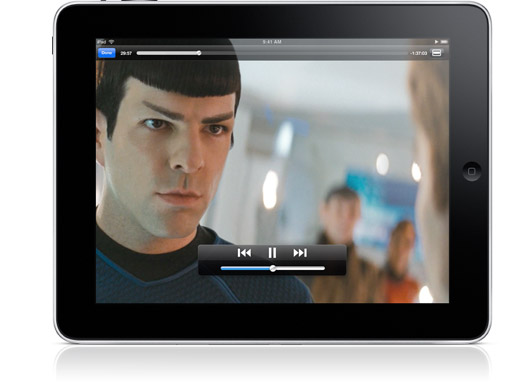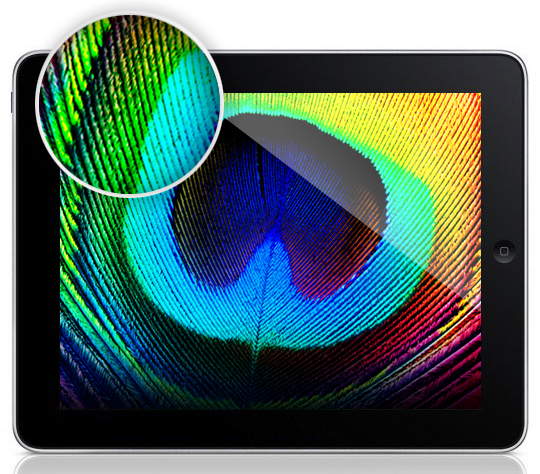Over the past few weeks there has been quite a back and forth discussion on the possible inclusion of a Retina or high resolution display on the iPad 2. Facts seemed to solidify when Engadget ran an article suggesting the second-generation iPad would have a high resolution display, though they did not specify the exact resolution. But then John Gruber yesterday seemed to disagree with that suggestion citing cost issues, uncovered UI graphics of an iPad camera app that are not optimized for a high resolution display and his own sources.
So why has there been so much doubt and to and fro-ing over whether the iPad 2’s display is high resolution? Well put simply, because there are so many barriers that would have to be overcome and issues that Apple would have to resolve. Click through to read the full article.
I must stress before I detail the barriers, this article is not a list of why the iPad will not have a high resolution display but the problems that Apple must have overcome to deliver one. That’s a subtle but important point I wish to stress!
Why is a resolution of 2048 x 1536 so frequently mentioned?
When the iPhone 4 gained a retina display it doubled the resolution from 480 × 320 to 960 × 640. The reason this was done was to ensure that not only was it simple for developers to redesign their apps (images just had to be twice as large) but any existing app that did not update the graphics would still look OK. The way it would work is any old graphics would have each pixel actually take up four pixels now (the resolution width was doubled and the height was doubled, thus a 4:1 pixel ratio).
However if the resolution was increased by a factor of say 1.8 those existing apps without updated graphics would have their images stretched 1.8 times and the result would be a much blurrier image because the pixels of the original image cannot take up 3.6 pixels on the retina display, so instead interpolation must occur (pixels blend together) and blurry hell emerges.
The iPad 2, if it were to have an enhanced resolution faces the same problem of what the iPhone 4 had initially; ensuring existing apps, which aren’t optimized for the higher resolution, don’t look terrible and blurry.
So if the iPad were to have a different resolution there would be three possibilities as also shown in the diagram above;
- [Best Solution] Resolution is doubled, any old UI element would have each pixel now take up 4 pixels, this would result in some blurriness but still relatively sharp results
- [Poor Result] Resolution is not doubled but increased by a decimal factor, this would lead to interpolation and even worse blur
- [Highly Unlikely] Apple boosts the DPI by keeping the same resolution but making the display physically smaller, this would create a crisp display but may mean UI elements are too small and Apple has been insistent they wont make a 7” tablet
Thus a doubling of the resolution is really the best solution for backwards compatibility with the non-optimized existing apps (as it was for the iPhone 4’s retina display) and this is why a 2048 x 1536 resolution (double the current) is commonly mentioned.
This section was inspired by this article at The iPhone Blog.
Cost
John Gruber covered this point perfectly, not only would a 10” display that had such a high pixel density be rather expensive, but the iPad would also need to power the graphics on it too and that wouldn’t be cheap either;
A 2048 × 1536 iPad display would seemingly be cost prohibitive today. Not just for the display itself, but for the RAM. The current iPad has 256 MB of RAM, which is shared between the CPU and GPU. I don’t think 512 MB of RAM would be enough for an iPad with a 2048 × 1536 display.
In addition it is presumable and logical that Apple would wish to keep the iPad price point reasonably low in order make the iPad as competitive as possible against the influx of tablets coming this year from a wide range of competitors and so such a cost increase as is likely to be required by a high resolution screen would be almost unthinkable.
 Content
Content
So by choosing the 2048 x 1536 resolution Apple could resolve the existing apps issue, what about all the content that people view on their iPad’s?
Video; Movie, TV, Podcasts
This is probably the easiest dilemma for Apple to resolve, so large is 2048 x 1536 that it is bigger than the resolution 1080p but really that wouldn’t matter much and 1080p content would look stunning on the iPad. 720p probably wouldn’t be recommended because it would have to be stretched around 1.5X it’s original resolution.
Thus the issue is getting 1080p content; Apple doesn’t currently offer any form of video in that resolution, only in the lesser 720p. It shouldn’t be too hard for them to start offering it on the iTunes Store considering others including Microsoft’s Zune streaming service offer 1080p movies.
Games
One of the iPad’s strongest features is undoubtedly playing one of many games that have been developed for use with the large touch screen. However if the resolution were increased to 2048 x 1536 it would seem logical that developers of graphics-heavy games like NOVA and Real Racing would want to take full advantage of that. Yet that would likely require an extremely powerful graphics chip compared to today’s iPad to handle those far larger graphics. To truly consider the scope of this one must only realize the Xbox 360 and PS3 only need to power a 1920 x 1080 display, and now you want an effectively mobile device to power a similar if not larger resolution?
In this respect it would seem like a years wait would not only deliver more powerful graphics chips but also more advanced batteries that could more feasibly deliver a high display resolution and allow developers to take advantage of it, whereas now it seems like a big stretch do that, let alone not inducing a cost blow out and massive battery life reductions.
Magazines
Magazine apps could also have annoying issues with a high-resolution screen update. Currently Wired magazine (and many of the other popular iPad magazines) are little more than lots of large static images of entire pages. This leads to a single issue of Wired for example weighing in at around 500mb, double the resolution and that effectively doubles to a whopping 1GB!
Apple would need to strongly prompt iPad magazine publishers to alternative methods of presenting the magazine, possibly working with Adobe on it’s Digital Publishing product or create an alternative method for the publishers to create iPad magazines. (Perhaps this is coming with Apple’s partnership with News Corporation’s ‘The Daily’?)
Other Minor Issues
- With apps having larger UI resources it would probably require larger iPad HDD’s, further adding to cost
- Most developers wont have screens with large enough resolutions to simulate the iPad in it’s full resolution
- Album art would look terrible if put full screen as it is now
- Running iPhone apps would look terrible, would probably require apps that are Retina display optimized
Again I’m not saying Apple won’t deliver a high-resolution display in their forthcoming iPad 2 release. It just seems there are too many issues at the moment, largely technological that just need some time be resolved. It will come, but whether it comes in the iPad 2 I am skeptical, yet at the same time very hopeful because going from the iPhone 4’s screen to looking at the iPad is almost painful with those pixels so clearly visible to me…


